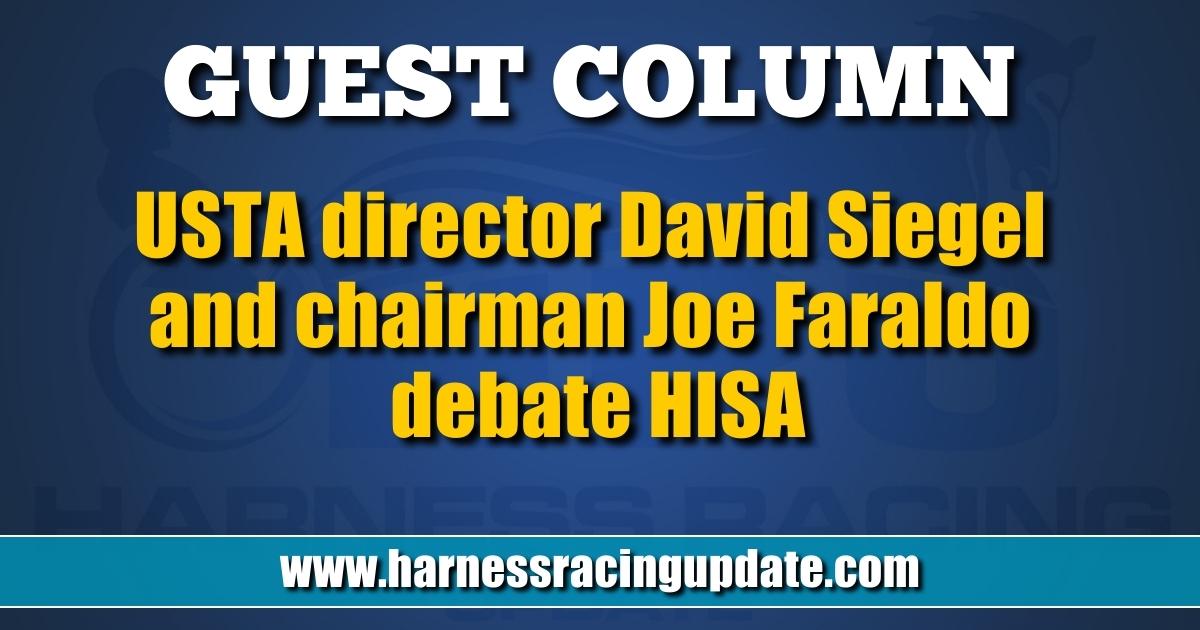

USTA director David Siegel and chairman Joe Faraldo debate HISA
Editor’s note: Recently, we received this letter from USTA director David Siegel about the Horseracing Integrity and Safety Authority (HISA). With Siegel’s blessing, we offered USTA leadership the opportunity to respond in the same issue. USTA chairman Joe Faraldo took us up on the offer.
A PRACTICAL VIEW OF HISA FROM A USTA DIRECTOR’S PERSPECTIVE
Let me begin by making it clear that the vast majority of USTA directors are dead set against the passage and implementation of HISA and believe it will do more harm than good to the standardbred industry. I am one of the few directors who do not agree with this position. I believe that the almost $1 million spent to date fighting this initiative is not the best use of the Association’s monies, nor do I believe that it is the best use of the time that our executive director, Mike Tanner, and other staff members have devoted to this issue.
Unfortunately, the USTA’s “newsroom” has become both a true newsroom for reporting the facts, as well as reporting the opinion of our president, Russell Williams. I truly wish they kept the facts and editorial separate, so our membership would not get confused between the two (fact and opinion).
The primary reason I think the USTA continually errs regarding this legislation is that it fails to think properly about protecting the many legislative achievements the various horsemen’s groups have attained in the so-called slot states. More than 90 per cent of the purse monies come from these favorable arrangements, and given the level of corruption (drugs) I believe exists throughout the industry, HISA has a much better chance to address this major issue than the status-quo, which is a joke. If the FBI and Five Stones investigation and subsequent convictions does not tell you that, then go ahead and befriend the ostriches with their heads in the sand.
It is now time to get realistic and face facts. HISA is here, at least for now. The standardbred industry is in the envious position to watch and learn. Lasix, for example, is still permitted in all but a limited number of races. Therefore, we can all watch and see what happens and what scientific studies have to say over the next couple of years. We will get to see how well HISA battles corruption in the thoroughbred industry and how effective it is in improving track and jockey safety (not really an issue for standardbred racing, but still very useful to see how effective HISA is working). We will get a better understanding of costs and most importantly the cost-benefit of the entire program. I think many of our directors and horsemen do not understand or remember that we are in such a better position than our thoroughbred brethren. They will have to learn from, and fund, the mistakes that occur with any new enterprise. We standardbred supporters have the luxury to ride the coattails of their experiences with none of the costs associated with the bumps that will come along the way.
So, while the USTA continues to utilize financial and human resources to fight HISA in the courts, I can only hope that those who influence our directorship do take this time to watch and learn. On the chance the efforts to fight end up in failure, the standardbred industry is in a position to intelligently phase us into the program in the best possible way when the time comes.
David Siegel / USTA director – District 3 –
California and the western U.S.
Joe Faraldo’s response
Every director has the right to an opinion about HISA, and each voices their opinion freely in the executive committee and board of directors’ meetings. At these sessions and from his perch in California, David Siegel has long been vocal in his criticism of the USTA’s opposition to this legislation. However, the vast majority of the USTA board, which is the sole voice for more than 19,000 participants in harness racing, opposes HISA and sees it for what it is — an existential threat to harness racing the minute harness racing is placed under its yoke.
Even as the support for HISA wanes amongst those who were once so quick to embrace it — specifically our thoroughbred counterparts and some harness elites — some of those in the halls of Congress who supported HISA and co-sponsored the law are planning to introduce a real corrective and constitutional alternative fashioned by the same USTA majority deeply concerned about its effects. The new legislation being contemplated by Congress will be breed-specific and governed by science, not optics for the sake of optics. Horses need therapeutic care like all other athletes, and science should direct such rules. Optics shouldn’t.
The mention of our having the option to see how things go with the thoroughbreds implies that if it goes badly for them, we will be able to correct any such wrongs that might be applied to us. Based upon experience, this is more than naive, it is disingenuous. Take one glaring example from the actual language of the HISA statute. To mislead people into thinking that the Lasix limitation currently in effect will remain so after the three-year study period ignores the fact that if just one arbitrary vote from a handpicked advisory committee is cast to end the use of race day Lasix, it is gone. There is no recourse or corrective action, not even from the FTC. This is the unfair, capricious treatment and rejection of input that we have seen in the past with complaints about picogram levels being called on amounts of therapeutics that could not enhance the performance of a fly.
Once HISA becomes entrenched, nothing is going to change. We must stop deluding ourselves with false hopes that all will turn out well. We have had experience with this in the past and have been unable to effectuate reasonable and science-based changes that are breed-specific. If you want to think things are going to change and our game will have effective input, think again.
Joe Faraldo / chairman, U.S. Trotting Association














